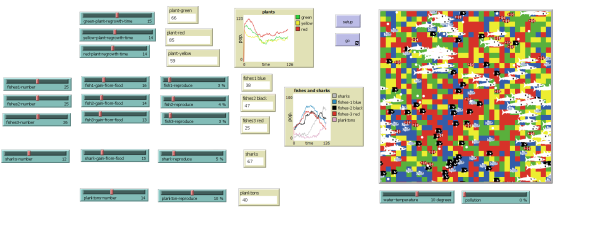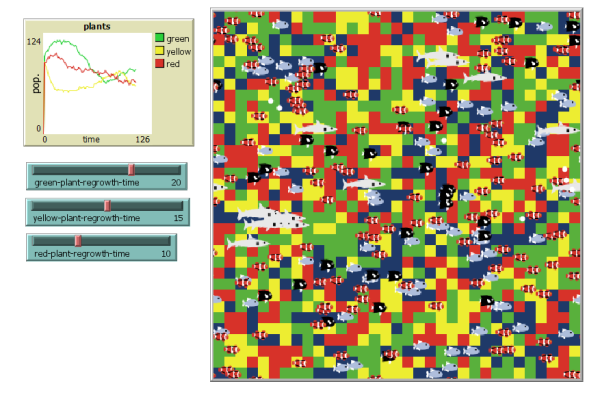Difference between revisions of "Aquatic ecosystem simulation"
(→Agents) |
(→Functions) |
||
| Line 93: | Line 93: | ||
'''Move Function''' | '''Move Function''' | ||
| + | |||
| + | The move function is consistent across all agents, differing only in the "pace" parameter, which is specified during the agent's creation. Each agent has its unique pace, selected based on its individual parameters | ||
rt random 50 | rt random 50 | ||
lt random 50 | lt random 50 | ||
fd pace | fd pace | ||
| − | |||
| − | |||
* Plankton pace 5 | * Plankton pace 5 | ||
Revision as of 19:54, 19 January 2024
Title: Aquatic ecosystem simulation
Author: Daria Tutynina
Method: Agent-based model
Tool: NetLogo
Contents
Introduction and problem definition
This simulation aims to replicate, in a simplified form, the intricate dynamics of marine life in the Pacific Ocean based on real-world scientific data. While the simulation is not an exact replica due to the immense complexity of marine ecosystems, it serves as a representative model. The focus lies on food webs, and interactions between species within the ecosystem. The primary goal is to explore how environmental changes impact marine populations.
Environment
The foundational environment of the simulation consists of a vibrant blue water body, hosting a diverse ecosystem of our agents. Within this aquatic realm, three distinct varieties of plants thrive, each represented by a different color.
to setup-ocean set ocean-color blue - 2 set green-plant-regrowth-time 20 set yellow-plant-regrowth-time 15 set red-plant-regrowth-time 10 ...
Green color (Spirulina)
The green color symbolizes spirulina, a microscopic cyanobacterium abundant in the water. This type of plant serves as a primary food source for a large portion of the fish population. Due to its rapid growth, spirulina provides a consistent and plentiful supply of sustenance for the aquatic organisms.
Yellow color (Coral Reefs)
The yellow color represents a highly specific type of plant, resembling coral reefs in the real world. These plants cater to a particular species of fish with a specialized diet. For instance, they might simulate the ecological role of coral species that grow at a moderate pace, offering sustenance to a specific type of fish adapted to this unique environment.
Red Color (Lemnaceae - Coffee Bean Plant)
The red color signifies plants that grow at a slower rate. These plants are consumed by fish with a mixed dietary preference.
Agents
- Fishes: Inspired by real Pacific Ocean species, each with specific traits such as energy levels, reproduction rates, and movement patterns. In this simulation, three distinct types of fish are introduced, each representing different fish families: fish1 (blue), fish2 (black), and fish3 (red). Each type is associated with different feeding strategies, reflecting various fish families.
The first type, fish1 (blue), represents Generalist Herbivores. These fish have a broader dietary spectrum and can consume a wide variety of different plant species. Their feeding behavior is characterized by the ability to adapt to and consume various types of plants, making them more versatile in their herbivorous diet compared to the specialized herbivores.
ask fishes1 [ move set energy energy - 1 eat-plants fishes1 green eat-plants fishes1 yellow eat-plants fishes1 red death reproduce-fish1 ]
The second type, fish2 (black), represents Specialized Herbivores. These fish exhibit a preference for consuming a very limited range of plant species, showcasing a specialized herbivorous feeding behavior. Their diet is focused on specific types of plants, and they are adapted to extract nutrients from these particular sources.
ask fishes2 [ move set energy energy - 1 eat-plants fishes2 yellow death reproduce-fish2 ]
The third type, fish3 (red), represents Omnivorous. These fish have a diverse diet, capable of consuming both plants and plankton. Their feeding behavior is not limited to a specific food source, allowing them to feed on a mixture of plants and small aquatic organisms. The omnivorous nature of these fish makes them adaptable to different environmental conditions and food availability.
ask fishes3 [ move set energy energy - 1 eat-plants fishes3 red eat-plankton death reproduce-fish3 ]
- Sharks: In this simulation, the concept of predators is represented by sharks. Sharks are carnivorous creatures, meaning they primarily consume other living organisms. The simulation models the behavior of predators, specifically sharks, within the marine ecosystem. The predatory nature of sharks is implemented in a way that allows them to consume all three types of fish: fish1, fish2, and fish3.
ask sharks [ move set energy energy - 1 eat-fishes death reproduce-sharks ]
- Plankton: In the simulation, plankton is represented as a type phytoplankton. Phytoplankton are microscopic, photosynthetic organisms that form the foundation of marine food webs. While in reality, zooplankton (which consumes other plankton) also plays a crucial role, for the purpose of simplification in this simulation, the focus is on phytoplankton. And this type doesn't has any function for feeding.
ask planktons [ move reproduce-planktons death-plankton ]
Functions
Every agent is equipped with three fundamental functions: move, eat, reproduce, and death. These functions form the core behaviors for each organism.
Move Function
The move function is consistent across all agents, differing only in the "pace" parameter, which is specified during the agent's creation. Each agent has its unique pace, selected based on its individual parameters
rt random 50 lt random 50 fd pace
- Plankton pace 5
- Shark pace 0.1
- Fish1 pace random-normal 1 0.5
- Fish2 pace random-normal 2 0.1
- Fish3 pace random-normal 1 0.1
Variables
- Water temperature - Influences the reproduction rates of fishes and sharks, reflecting observed correlations in the Pacific Ocean.
- Pollution - Affects the regrowth time of plants, mirroring real-world impacts on marine life.
Results
This simulation provides a simplified yet insightful exploration of the Pacific Ocean's marine ecosystems, drawing inspiration from real-world scientific data. The incorporation of representative data supports understanding potential impacts of environmental changes on marine populations, despite the inherent complexity of the actual ecosystems.
NetLogo File
Below I attach the source file


